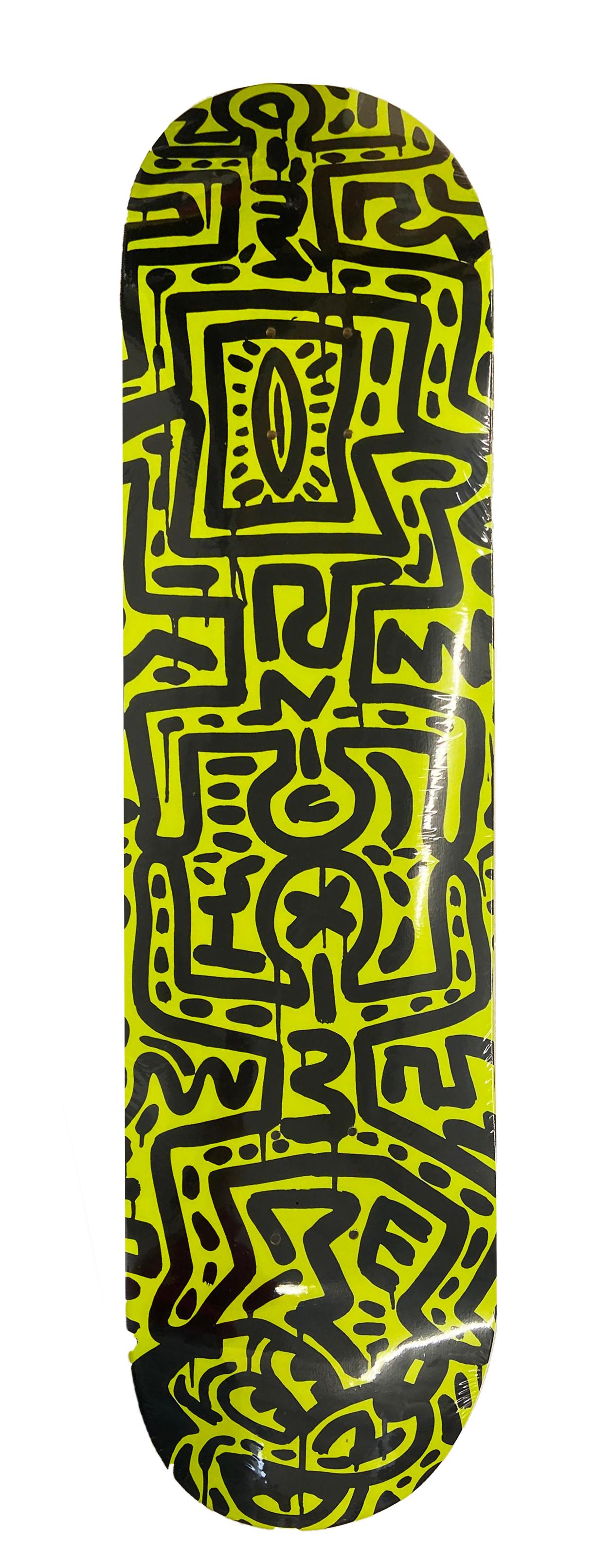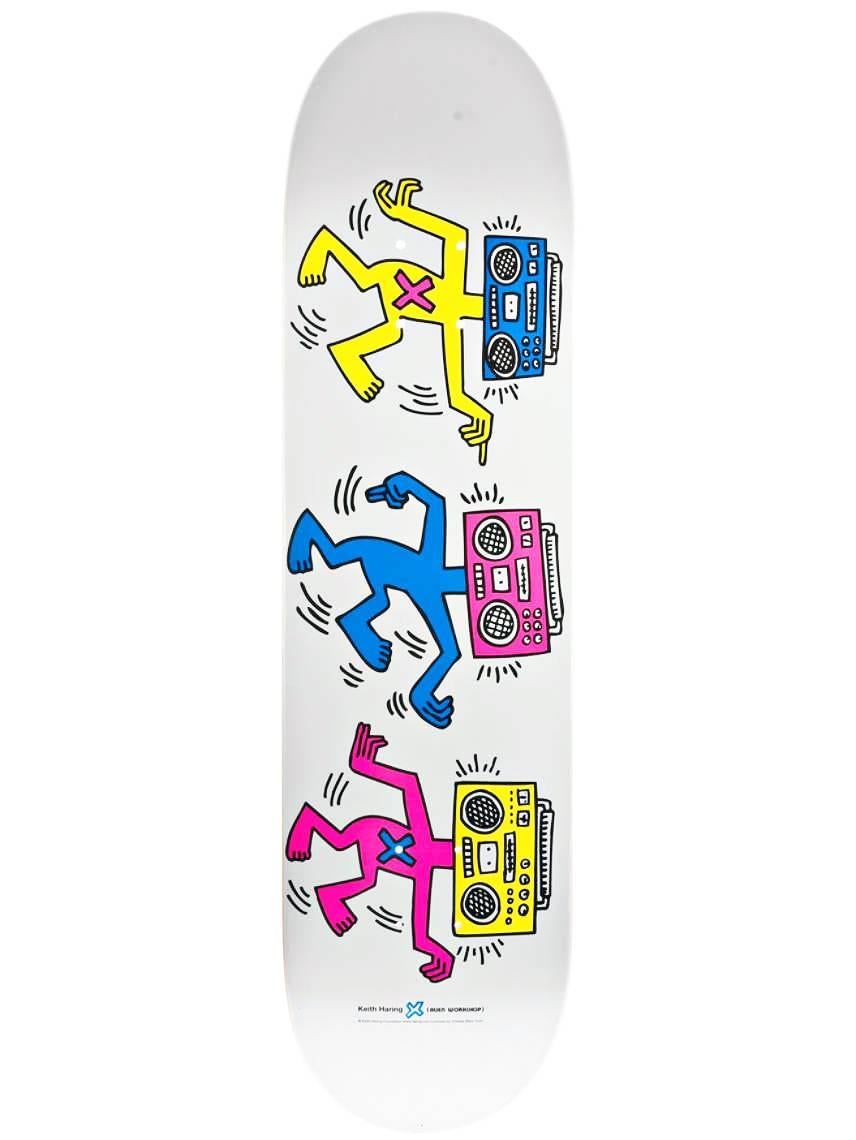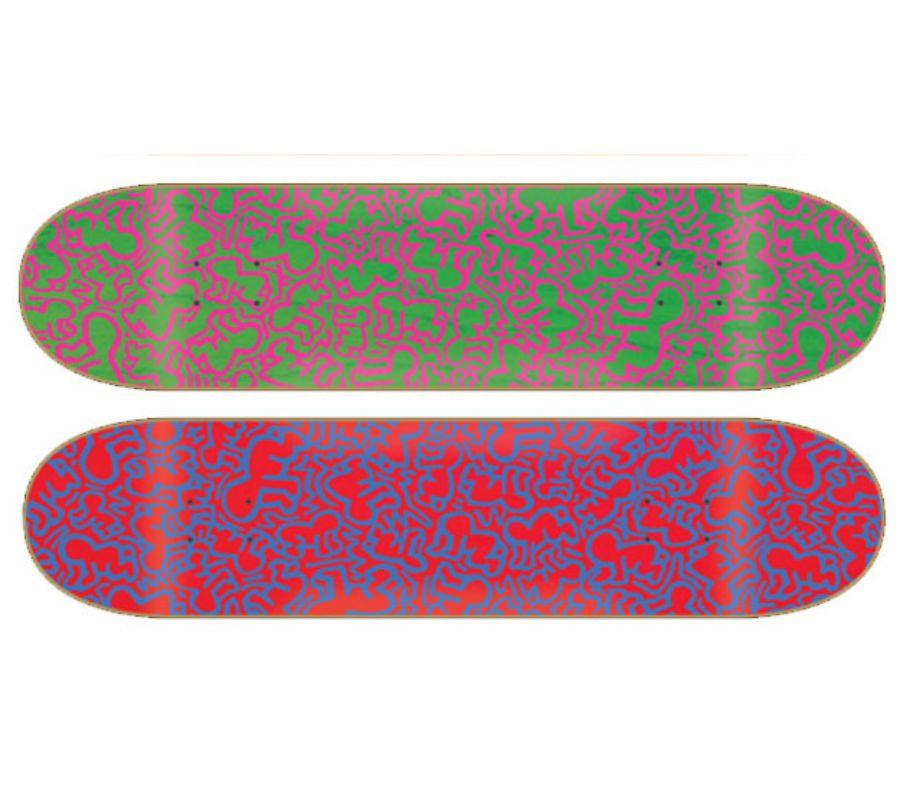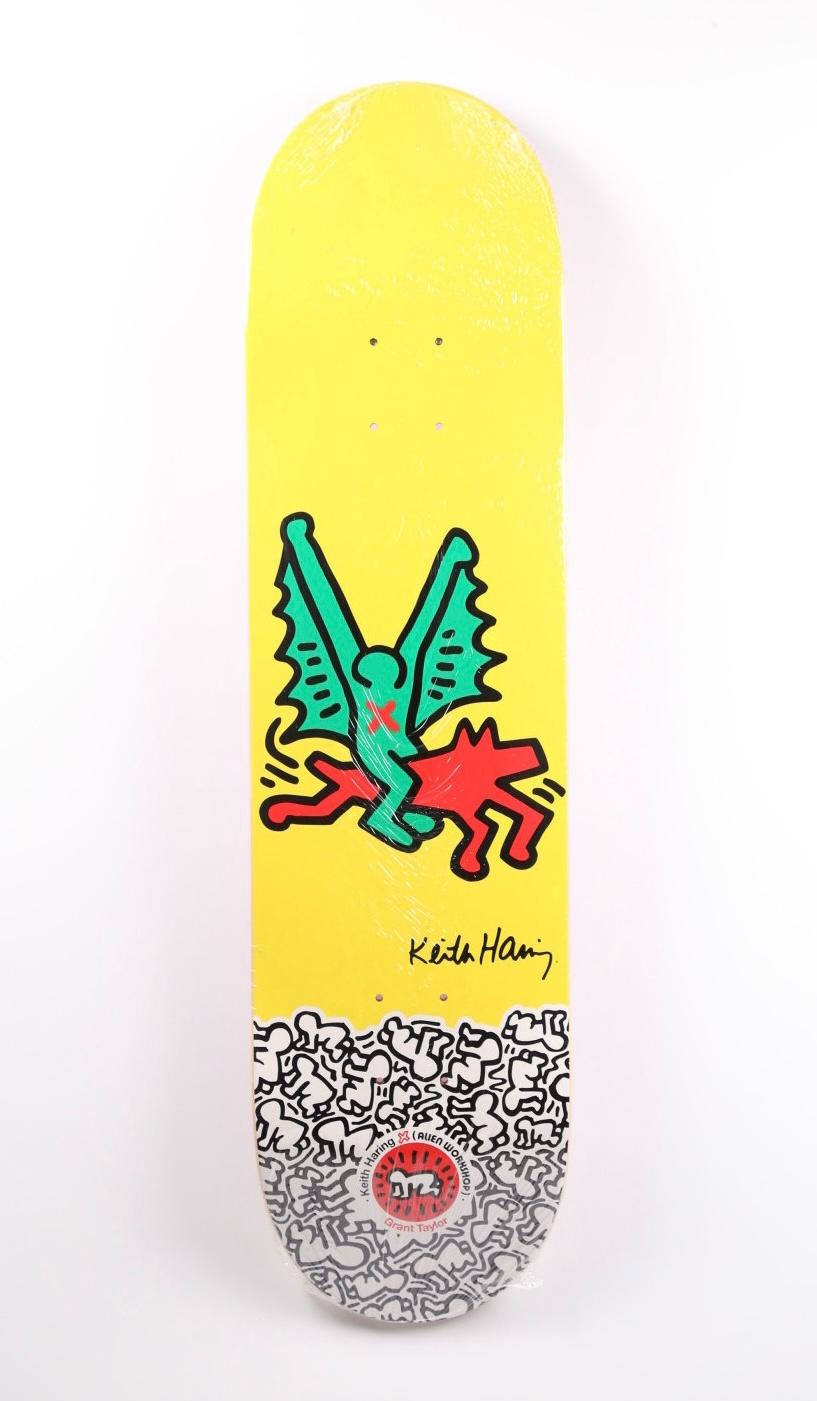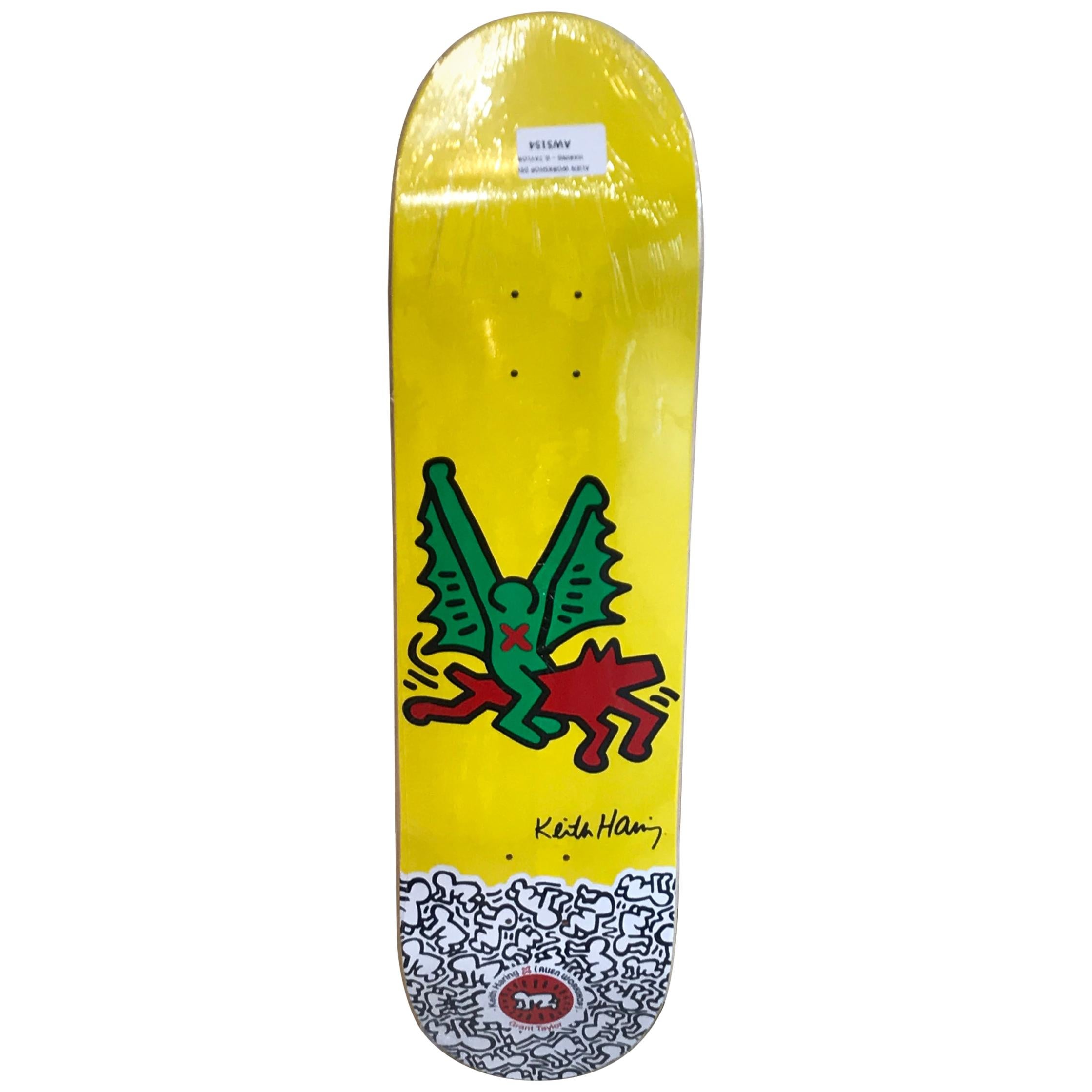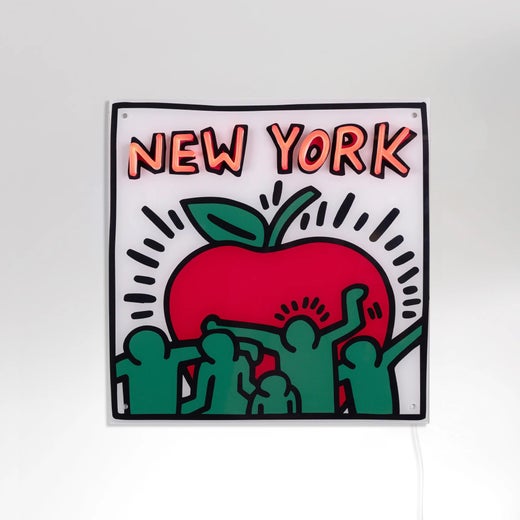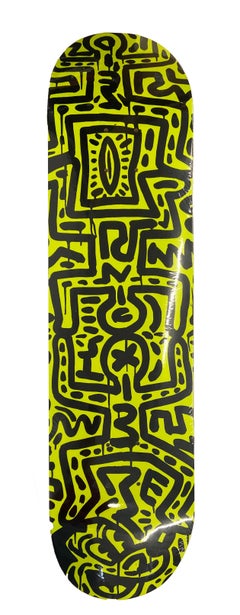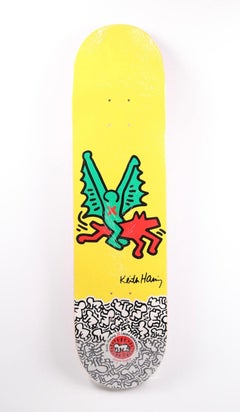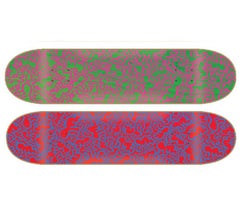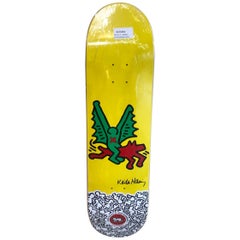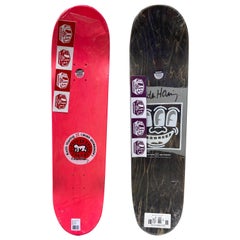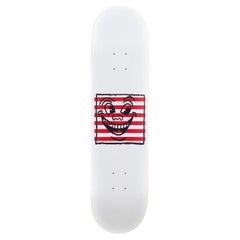Items Similar to Keith Haring crawling baby Skateboard Deck (Keith Haring skate deck)
Want more images or videos?
Request additional images or videos from the seller
1 of 8
(after) Keith HaringKeith Haring crawling baby Skateboard Deck (Keith Haring skate deck)c.2013
c.2013
$395
£307.53
€349.75
CA$568.20
A$624.26
CHF 326.24
MX$7,444.87
NOK 4,131.14
SEK 3,848.50
DKK 2,613.53
About the Item
Vintage Keith Haring Skateboard Deck featuring the artist's most recognized & iconic image, the Crawling Baby. This work originated circa 2013 as a result of the collaboration between Alien Workshop skateboards and the Keith Haring Foundation.
With the estate licensed Haring printed signature on the reverse. Makes for unique, vibrant wall-art that hangs with ease. This work is out of print and will not be reproduced.
Medium: Silkscreen on maple wood skate deck.
Approximate Dimensions: 8 x 31 inches.
Condition: Good overall vintage condition. Minor storage wear & markings to front and reverse. Far edge of deck contains wear not effecting or visible to artwork.
Keith Haring (b.1958 Reading, PA):
From a young age he enjoyed drawing, especially Disney characters and other cartoons. He initially wanted to become a commercial artist but after a year at the Ivy School of Professional Art in Pittsburgh, Haring dropped, moved to New York City and enrolled in the School of Visual Arts (SVA). Haring immediately felt connected to the thriving alternative arts scene happening downtown in the late 1970s and became friends with Jean-Michel Basquiat and Kenny Scharf.
Haring’s first major works were his subway drawings. Haring produced a large number of these public works between 1980 and 1985, integrating his motifs outlined figures into everyday public space in a way that directly engaged its viewers.
Haring's 1st solo exhibition was held at Westbeth Painters Space in 1981 and a celebrated show debuted at the historic Tony Shafrazi Gallery in New York the following year.
Throughout the 1980s, Haring was committed to democratizing the art experience and along with paintings, he also created theater sets, billboards, murals, advertising campaigns and even a line of Swatch watches. In 1986 he opened the Pop Shop in SoHo, selling apparel, posters and toys bearing his drawings. This was a controversial move, as many galleries criticized Haring for “de-valuing” the art object while others, such as Andy Warhol, championed Haring’s insistence on making art accessible and affordable. Pop Shop was highly influential to contemporary crossovers of art and merchandise that are now so dominant, as in the work of Jeff Koons, Yayoi Kusama, KAWS and Takashi Murakami.
In addition to this ideology of accessibility, Haring was also very socially engaged and used his striking imagery to promote awareness of various political and social campaigns. His many notable public works included a mural on the western side of the Berlin Wall, the Crack is Wack mural in New York, and a mural for the 100th anniversary of the Statue of Liberty in 1986. Haring was diagnosed with AIDS in 1988 and used his presence in the arts community to raise awareness of the crisis. In 1989, a year before his death, he established the Keith Haring Foundation, whose mission is to raise funds for AIDS organizations and children’s literacy and arts programs.
Since his death in 1990, Haring has become one of the most widely-recognized and celebrated artists of the 20th century.
Related categories:
Keith Haring skate deck. Keith Haring skateboard deck. Skate art. Basquiat. Andy Warhol. Pop Art. Graffiti. Street art. Keith Haring Crawling Baby.
- Creator:(after) Keith Haring (1958 - 1990, American)
- Creation Year:c.2013
- Dimensions:Height: 31 in (78.74 cm)Width: 8 in (20.32 cm)
- Medium:
- Movement & Style:
- Period:
- Condition:
- Gallery Location:NEW YORK, NY
- Reference Number:1stDibs: LU354314814332
(after) Keith Haring
Keith Allen Haring was an American artist whose pop art emerged from the New York City graffiti subculture of the 1980s.
About the Seller
5.0
Vetted Professional Seller
Every seller passes strict standards for authenticity and reliability
Established in 2014
1stDibs seller since 2016
4,594 sales on 1stDibs
Typical response time: <1 hour
- ShippingRetrieving quote...Shipping from: NEW YORK, NY
- Return Policy
More From This Seller
View AllKeith Haring Skateboard Deck
By (after) Keith Haring
Located in NEW YORK, NY
Keith Haring Mickey Mouse Skateboard Deck:
Standout Keith Haring Skateboard Deck featuring lush, vibrant, fun colors & classic early 1980s Keith Haring Mickey Mouse imagery. A brilliant piece of Haring wall-art that hangs with ease.
This work originated from the sold out collaboration between Diamond Supply and the Keith Haring Foundation. The deck is housed in its original shrink-wrap and bares the copyright of the Haring foundation on the reverse.
Medium: Maple wood skateboard deck. 2021.
Approximate Dimensions: 8.0 x 31 inches (20.5 x 79 cm).
In original shrink wrapping; excellent overall condition.
Estate trademark & Haring printed signature on the reverse. From sold out/out of print edition of unknown.
Keith Haring rose to prominence in 1980s New York within the East Village art scene alongside Jean-Michel Basquiat, Kenny Scharf, and Jenny Holzer. He bridged the gap between the art world and the street, graffiting city subways and sidewalks before committing to a studio practice. Haring united the appeal of cartoons with the raw energy of Art Brut artists such as Jean DuBuffet as he developed a distinct pop-graffiti aesthetic that comprised energetic, boldly outlined figures against solid or patterned backdrops. His major themes included exploitation, subjugation, drug abuse, and the threat of nuclear holocaust; Haring boldly engaged with social issues, especially after receiving an AIDS diagnosis in 1987. Today, his work sells for seven figures at auction and has been the subject of solo shows at the Brooklyn Museum, the San Francisco Museum of Modern Art, and the Albertina Museum in Vienna, among other institutions.
Related Categories
Pop Art. Graffiti. Street art. skate art...
Category
1980s Pop Art Prints and Multiples
Materials
Wood, Offset
Keith Haring Skateboard Deck (Keith Haring Mickey Mouse)
By (after) Keith Haring
Located in NEW YORK, NY
Keith Haring Mickey Mouse Skateboard Deck:
Standout Keith Haring Skateboard Deck featuring lush, vibrant, fun colors & classic early 1980s Keith Haring Mickey Mouse imagery. A brilli...
Category
1980s Pop Art More Art
Materials
Wood, Offset
$380 Sale Price
20% Off
Keith Haring Skateboard deck 2012 (Keith Haring skate deck)
By (after) Keith Haring
Located in NEW YORK, NY
Rare Out of Print Keith Haring Skateboard Deck featuring the artist's iconic Boom Box men.
This highly decorative Keith Haring skate deck originated circa 2012 as a result of the co...
Category
21st Century and Contemporary Pop Art Figurative Prints
Materials
Wood, Screen
$460 Sale Price
20% Off
Keith Haring Skateboard Deck (Keith Haring dragon)
By (after) Keith Haring
Located in NEW YORK, NY
Keith Haring Skateboard Deck c.2012:
Rare, out of print Keith Haring skate deck featuring one of the artist's iconic dragon images, set amidst a vibrant array of colors that really p...
Category
1980s Pop Art Sculptures
Materials
Wood, Screen, Lithograph
Basquiat Keith Haring skateboard decks (set of 2 works)
By Jean-Michel Basquiat
Located in NEW YORK, NY
Jean-Michel Basquiat & Keith Haring Skateboard Decks (set of 2 individual works):
A standout Basquiat & Keith Haring Skateboard Deck set - with each piece trademark by their respecti...
Category
1980s Pop Art Prints and Multiples
Materials
Epoxy Resin, Wood, Lithograph
Price Upon Request
Keith Haring set of 10 skateboard decks (Keith Haring alien workshop)
By (after) Keith Haring
Located in NEW YORK, NY
Vintage Keith Haring Skateboard Deck Set (10 works):
This superbly printed, rare, eye-catching complete set of 10 Keith Haring skate decks or...
Category
21st Century and Contemporary Pop Art Figurative Prints
Materials
Wood, Screen
You May Also Like
Untitled (skateboard set of 2)
By Keith Haring
Located in Washington , DC, DC
Untitled (skateboard set of 2)
Category
21st Century and Contemporary Contemporary More Art
Materials
Board, Screen
$1,480 Sale Price
20% Off
Skate Board Limited Edition Keith Haring
Located in Saint Ouen, FR
Skate board limited edition Keith Haring
Édited by alien workshop
circa 2008.
Deco recto et verso
New
Wrapped in plastic with stickers et étiquet
Pla...
Category
Early 2000s Figurative Sculptures
Materials
Other
Keith Haring, Baby Skate Board Collector
Located in Saint Ouen, FR
Keith Haring - Baby
Skate board Collector
Published by Alien workshop
circa 2008
Front and back decoration
80.5 x 20.5 - size 825 XX
Condition :...
Category
Early 2000s American Picture Frames
Materials
Wood
Untitled 'Smile on Stripes' Skateboard Deck by Keith Haring
Located in Jersey City, NJ
The Skateroom w/ ©Keith Haring Foundation
Set of 3 skateboard decks
7-Ply Canadian Maplewood with screen-print
Measures: 31 H x 8 inches, each
Mounting hardware included
Open ed...
Category
2010s Belgian Wall-mounted Sculptures
Materials
Maple
Keith Haring, DILL Skate Board Collector
Located in Saint Ouen, FR
Keith Haring - DILL
Skate board Collector
Published by Alien workshop,
circa 2008
Front and back decoration
Measures: 80.5 x 20.5 - size 8
Conditi...
Category
Early 2000s American Picture Frames
Materials
Wood
Collection of 20 skateboard decks
By Keith Haring
Located in Washington , DC, DC
Rare collection of 20 skateboard decks produced by Alien Workshop with full authorization from the Haring Foundation
Category
21st Century and Contemporary Contemporary More Art
Materials
Board, Screen
More Ways To Browse
Unique Vintage Wall Art
Used Swatch Watches
1986 Watch
Skateboard Deck Basquiat
Keith Haring Deck
Keith Haring Skate
Keith Haring Skateboard
Skate Decks Keith Haring
Bernd Zimmer
Birth Of Venus Botticelli
Calder Dlm
Calder Lithograph 1972
Charlie Waite
Ellsworth Kelly Galerie Maeght
Expressionist Erotic Art
Georges Chakra
Gerhard Richter Signed
Gudmund Olsen
